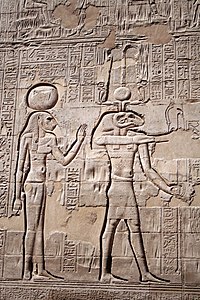Menhit
| Menhit in hieroglyphics | ||||||||
|---|---|---|---|---|---|---|---|---|
Menhit |
||||||||
| or |
|
|||||||
| transcription | MnḤjt | |||||||
| Menhit (left) and Khnum (right) on the outer wall of the Temple of Esna | ||||||||
Menhit is a goddess in Egyptian mythology . She was a goddess of battle, but was also considered a crown goddess.
presentation
Menhit is depicted as a lion-headed woman. Rare pictures show her only as a woman with a sun disk and a uraeus snake on her head.
Cult and cult places
A main cult place of the Menhit was Esna , the Greek Latopolis, where she formed a trinity together with Khnum and her son Heka-pa-chered . Sais is known as another main place of worship .
meaning
Her portrayal as a woman with a lion's head brought Menhit into close association with the goddesses Sachmet , Bastet and Renenutet . With the approach of Khnum to Shu, Menhit also took the place of the goddess Tefnut . In this local form it was part of the myth of the sun's eye . In this context, the fire-breathing uraeus snake is sometimes referred to as a menhit. So it is possible that Menhit was initially just a name of the uraeus snake itself and that the relationship with the goddess Menhit in lion form was only gradually established.
Her name, which can be translated as the "butcher", describes her as the goddess of battle. Illustrations of the battles of Seti I , for example, show the king with the epithet "loved by Menhit". Menhit was less known to the people in her wider role as the crown goddess.
See also
literature
- Hans Bonnet : Lexicon of the Egyptian religious history. 3rd unchanged edition, Nikol, Hamburg 2000, ISBN 3-937872-08-6 , pp. 451–452.
- Rolf Felde: Egyptian deities. 2nd expanded and improved edition, R. Felde Eigenverlag, Wiesbaden 1995, p. 34.
- Richard H. Wilkinson : The world of the gods in ancient Egypt. Faith - Power - Mythology. Theiss, Stuttgart 2003, ISBN 3-8062-1819-6 , p. 179.
